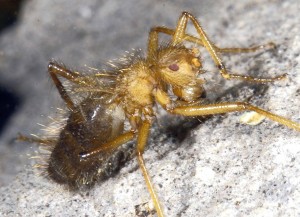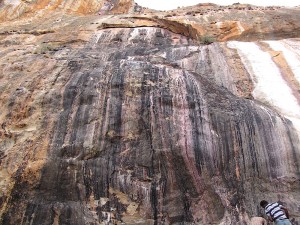 Like an X on a pirate’s treasure map, Robert Copeland uses bat urine stained rock faces in Kenya’s dry-country hills to locate a treasure of a different kind. The Terrible hairy fly (Mormotomyia hirsuta Austen), once described as the world’s most rare fly, was last seen in 1948. It piqued the interest of Robert Copeland from the International Centre of Insect Physiology and Ecology in Kenya.
Like an X on a pirate’s treasure map, Robert Copeland uses bat urine stained rock faces in Kenya’s dry-country hills to locate a treasure of a different kind. The Terrible hairy fly (Mormotomyia hirsuta Austen), once described as the world’s most rare fly, was last seen in 1948. It piqued the interest of Robert Copeland from the International Centre of Insect Physiology and Ecology in Kenya.
After investigating the fly’s only known area of occurrence and knowing the flies lay their eggs in bat guano, Dr. Copeland observed pinkish and black stains on the rock face and made a significant discovery. The stains on the rocks, “made from a slurry of bat urine and guano,” may indicate the presence of the terrible hairy fly.
“We were able to develop a profile of the kind of microhabitat in which Mormotomyia is likely to be found; narrow, horizontal cracks in near-vertical rock faces with characteristic pinkish-purple staining of the rock immediately below the crack, caused, presumably, by bat urine.”
Armed with binoculars and a search image (pink and black stained rock face), extensive fieldwork revealed three more locations holding terrible hairy flies. One of the locations was 200 km away from the others. A curious discovery given the fly is wingless.
Recent reports from field workers indicate that the type locality, Ukasi Hill, is being fenced. The grant recipient had, some time ago, requested that the National Museums of Kenya consider gazetting Ukasi as a National Monument. “We do not, as yet, know if the fencing signals a recognition of its conservation importance (we have also found several other rare or undescribed insect species at the site) but we hope that that is the case,” reports Dr. Copeland.


